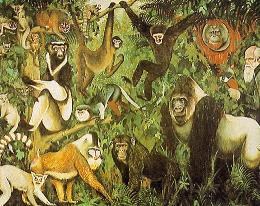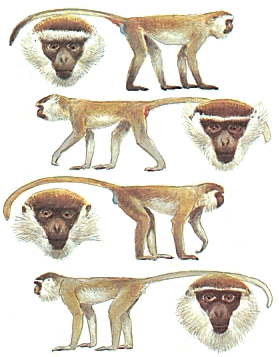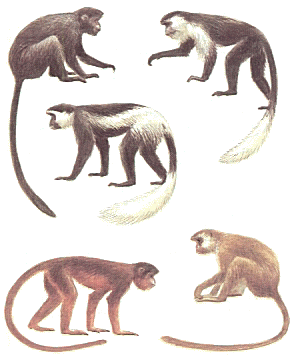 |
[ Menu | Prosimians | New World Monkeys | Old World Monkeys | Gibbons & Great Apes ]
[ Primate Species Index ]
[ Return to ZOOLOGY
| Return to EVOLUTION ]
Illustrations � 1993, 1994 by Bruce Pearson
in Animals of the World
used by permission of Running Press Book Publishers
Field Guide Artistry Permits Species Comparisons
|
Four species of African Vervet Monkeys are illustrated at right. From top to bottom they are:
The artwork at right has been enlarged by about 50% over the size appearing in a small field guide. By using illustrations rather than photographs, the artist is able to convey an excellent idea of the differences between species or subspecies. Fine details of pelage, scrotal coloration, forehead stripe, eye-ring and other features may be shown. However, even more examples might be given to illustrate gender, age and geographic variations.
|

|
Five Species of Colobids -- Another African Group

|
The five species of Colobids shown here include: | |
|
Black Colobus
Colobus satanas |
Angolan Colobus
Colobus angolensis |
Abyssinian Colobus
Colobus guereza |
|
Red Colobus
Colobus badius |
Olive Colobus
Procolobus verus | |
|
| ||
Good Illustrations Bring Animals to Life

|
Remember how important scaling of size can be. The Tarsiers shown at left are much smaller animals than those in the two plates shown above. They can rotate their heads nearly 360�. From the top down these are:
 Lar Gibbons, Hylobates lar, can brachiate (swing forward from branch to branch by hand) up to 30 feet at a time, faster than you can run. |
[ Menu | Prosimians | New World Monkeys | Old World Monkeys | Gibbons & Great Apes ]
[ Primate Species Index ] [ Return to ZOOLOGY | Return to EVOLUTION ]